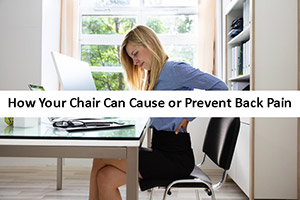
There’s a reason even youngsters and people in their mid-30s also frequently complain about back pain and stiffness. Let’s face it, a sedentary lifestyle isn’t just a choice anymore. It’s a necessity. Some of us have to sit in front of a computer for 8-10 hours a day to earn our living.
It’s safe to say that this whole new sedentary work culture has taken quite a toll on our back muscles and tissues. The standard office chairs aren’t ergonomically designed to take the disc pressure off our spine.
Sitting in a slouched or hunched position is more of a reflex when you’re sitting on a poorly made chair. All these contribute to a lingering pain in the lower back, hip, and neck area. And that’s not even the tip of the iceberg.
On the other hand, sitting on an ergonomic chair that’s suitable for your body weight, width, and height can alleviate the pain and discomfort to a great extent.
These chairs are specifically engineered to take the strain off your spine and promote healthy posture. So you can focus more on the task at hand, unperturbed by that annoying back pain and stiffness.
We will talk in-depth about how a good ergonomic chair can dramatically improve your spine health and posture. But before that, let’s discuss why and how a chair causes back pain.
Relationship between Chair and Back Pain- Here’s What You Need to Know
Chair putting excessive disc pressure on the spine is the main reason why our back hurts after prolonged sitting. If you are interested in the biology behind it, allow me to elaborate.
Spine is the central support of our body structure. It helps us walk and move freely. But most importantly, it supports our spinal cord, which is a bundle of nerve fibers that connects our brain to the rest of our body.
In short, we would be no less than a vegetable without a strong spine. Here’s how sitting too long on a poorly constructed chair takes a toll on our back:
Increased Disc Pressure
Prolonged sitting on a chair that doesn’t have adequate support for our body proportions can add huge amounts of pressure on the spinal discs.
Lack of Enough Lumbar Support
The absence of any solid lumbar support means we will inevitably slouch, lean too far back, or slump on one side for far too long. Doing so overstretches the spinal ligaments and discs, which could lead to muscle strain in the lower back.
If you are wondering why your back and hips are stiff as a brick after sitting for too long, you have your answer now.
The Effects of Force and Motion
The force from our upper body makes its way to the lumbar region of the spine, located at the lower back. Over time, this excess load on your lower back can trigger a serious musculoskeletal disorder.
Too Much Hunching
Most of us spend our free time sitting on our living room chairs reading a book, browsing our Insta feed, streaming videos on our phones, or watching television.
Our natural tendency to hunch over our phone or tablet throws our back out of alignment. In medical terms, this condition is known as kyphosis. In layman’s terms, it’s hunchback due to poor posture.
This not only affects your back but also your neck and shoulder by putting excess strain on the muscles and ligaments that support your neck.
Back Cracking and Grinding
Chairs that don’t have a swiveling seat pan make you twist your back way too much when you have to turn around or pick up something from the side.
The act of constantly adjusting and manipulating your spine’s facet joints out of neutral position causes back cracking.
If your back makes a popping sound every time you twist, coupled with a burning sensation, it may be a sign of cartilage degeneration.
Now, I don’t want you to get outrageously alarmed by all these. Almost 80% of Americans experience lower back pain at some point in their lives. So you and I are definitely not the only ones.
If you are serious about improving your spine and back health, making a small change can leave a huge positive impact. For starters, replace your standard office and living room chairs with ergonomic chairs.
How Chairs Can Alleviate and Prevent Back Fatigue
When looking for a computer chair for long hours of sitting, know there’s no one-size-fits-all model. Each one of us is designed differently. So focus on finding a chair that’s suitable for our body proportions.
The job of your chair should be to share the load of supporting our body weight with our back. The lesser the strain on your back muscles and spine ligaments, the better it is.
So, how do you choose a computer chair or living room chair to ease back pain? Below I’ve squeezed in all the key guidelines into a checklist to help you pick the perfect chair:
Lumbar Support
You have heard that term a lot, haven’t you? The field of ergonomics heavily focuses on the importance of reducing stress from our lumbar discs while sitting.
A solid lower back support or lumbar support in your chair will help your lumbar spine maintain its natural curvature. Our spines are designed to do so without any external support. But when we are sitting for too long, it’s only normal to get tired and slump.
Therefore, a good lumbar support will eliminate the need to slouching over or down too much. That, in turn, would mean less pressure on your lumbar discs, hence less lower back cramp.
Dynamic Backrest
Sitting too long on a chair with a static back forces you to stay in one position, which can be tiring after an hour. Sitting in one position for far too long can amplify the strain on both your upper and lower body, causing muscle pain.
So when looking for an ergonomic chair, choose one with a dynamic backrest, i.e multiple recline, and tilt adjustability. Such backrests will effectively support your entire body weight in all positions.
Cushion Support
The job of the seat cushion is to help our body relax so that we can ease up our muscles. We subconsciously tense up our muscles to support our body structure and weight.
A super-soft cushion fails to provide adequate support, increasing muscle tension which ultimately leads to back pain and stiffness.
On the other hand, an overly firm cushion distributes the force of our weight into the muscles, causing discomfort and pain.
Our takeaway? The seat and back support cushion should hit the sweet spot between softness and firmness.
Accessibility of Chair Controls
Chairs boasting a wide array of adjustments are great. But the whole thing is pointless if you have to twist and bend too much and too often to reach the controls.
To keep your spine healthy and happy, pick a chair that lets you adjust the tension, tilt, seat height, and seat pan depth with minimal effort.
Adjustable Armrests
Armrests are often the most overlooked part when shopping for a chair. That kind of explains why a lot of people start feeling neck and shoulder stiffness after half an hour of sitting upright.
Height-adjustable, broad and cushioned armrests are the bare minimum requirements for sitting comfort and good spine health. If you can afford to spend a bit more, invest in a chair that lets you customize the armrest angle as well.
The Bottom Line
Now that you know how much taxing chairs can be on your back muscles and spine, it’s time to look for an ergonomic that’s well-suited to meet your specific needs. Remember that the more customization it offers, the better it is for your back health.
But such chairs can cost top dollars. If you don’t have a high budget, don’t worry. Seat height adjustment, a tilting backrest, and good lumbar support are the three most important aspects of a quality ergonomic chair for long hours of sitting.
As long as your choice of model ticks these three boxes, you are good to go.
